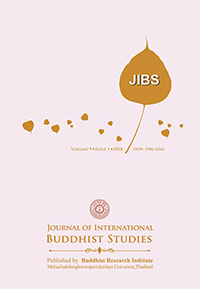The Development of Instruction Media in Accounting Using the Jātaka Story for Blended Learning in the 21st Century
Keywords:
Blended Learning, Jātaka Story, E-learningAbstract
This experimental research aimed to develop e-Learning with Jātaka story instruction media in order to achieve the required criteria, to compare the outcome of learning using e-learning with the Jātaka story with the criteria 80, to compare pre- and post-learning outcomes, to study the useful moral teachings from e-Learning with the Jātaka story, and to analyze what the learners gained from learning using the Jātaka story. The sample group was 75 students from the Culinary Arts and Technology Program, Rangsit University, who registered in Accounting for Non-Accountants, S/2017. The students had self-study with e-Learning using the Jātaka story about the break-even point, and had two tests: pre-test and post-test, and completed the questionnaire. The statistics used for data analysis were mean and t-test. The findings showed that the efficiency of e-Learning with the Jātaka story met the required criteria: 81.60/80.65. The hypothesis testing revealed that the achievement during and after learning using e-Learning with the Jātaka story was 80, without the difference between the two tests. The top three moral teachings the learners implemented were: Mistake wrong for right; Land on your feet, and Gratitude, respectively. From learning with e-Learning using the Jātaka story, the first three benefits the learners gained were the use of information technology (96.00%), morals and ethics (90.67%), and creativity and imagination (86.67%).
References
Artsub,S., Kunkum,S and Sitipoomongkol,A.(2013). Effectiveness of Moodle E-learning for Kinesiology Students (SPSS 217 Sports Information and Illustration). Journal of Professional Routine to Research, 2, 81-89..
Chindanurak,T.(2016). Innovation and Media in Science Teaching and Learning in the 21st Century. Veridian E-Journal, Silpakorn University, Humanities, Social Sciences and Arts,9(1),560-581.
Jettabut,A., Nillapun,M. (2013). The Development of Multimedia on Thai Spelling Writing for Fourth Grade Students. Silpakorn Educational Research Journal,5 (1),157.
K, Adisron.(2017). Development Report of Programmed Instruction for Matthayomsuksa 1 Students Subjects Reading for Learningof Nuannoradit Witthayakhom Rachamangkhalaphisak School. Proceeding The 7th STOU National Research Conference Sukhothai Thammathirat University.
Kelley, A. C. (2011). Designing an e-book for a fifth-grade classroom. A PROJECT REPORT. Master of Arts Educational Technology, California State University.
Khetjoi,S., Thasa, w.(2017).The Buddhist Principles of social Justice : An Application in social Work Practice. Journal of International Buddhist Studies Vol.8 No.1; June 2017: 167-181
Makaramanee, R.( 2014).Learning Design for The 21st Century. Article published in the document for The Teachers’ Council of Thailand Academic Conference 2014 on 14-15 September 2014 at Miracle Grand Convention Hotel, Bangkok.
Marrone, A. (2015). The effects of enhanced e-books vs. traditional print books on reader motivation, comprehension, and fluency in an elementary classroom. Research paper in Education. Master or arts in teaching, William Paterson University of New Jersey.
Meesri,P., Meesri.,A.(2015). The Development of an Electronic Instructional Package on Computer Programming Language 1 on “Iteration” for the students of Valaya Alongkorn Rajabhat University under the Royal Patronage. Valaya Alongkorn under the Royal Patronage Development and Research Journal, Science and Technology Vol.10 No. 1 (January-April 2015:49).
Ministry of Education. (2012, February) Effective Leaning with Iddhipada 4. Retrieved on 2 January 2017 from http://www.moe. go.th/moe/th/news/detail.php?NewsID=27230&Key=news_research
Office of the Education Council, Ministry of Education. (2017).
National Educational Plan. Printed at Prikwarn Graphic Co., Ltd. Bangkok.
Pannim,P.(2016). Development OF web-based instruction model blended with cooperative learning. Valaya Alongkorn under the Royal Patronage Development and Research Journal, Science and Technology, 11(2),121-129.
Paowpan, N. et. al. (2011). A Study on Learning English Vocabulary through a Visual Memory Model based on Theory of Multiple Intelligence for Vocational Diploma Students, Teerapada Technology School, Roi-Et Province, Rajabhat Maha sarakham University Journal, 5(3), 57-65.
Promwong,C.(2013). Efficiency Test for Visual Media or Instruction Media. Silpakorn Educational Research Journal, 5(1).
Sripum ,T.(2014). Frame Story and Teachings Assertion in Thai Jātaka Literature.Humanities Journal, 21 (1), 59.
Thongsuwan,K.,Meejang, A.(2017). The Effects of Using Tales on English Reading Comprehension, Vocabulary Knowledge, and Vocabulary Retention of Prathom Suksa VI Students of Watdonkaitia School in Phetchaburi Province. Proceeding The
th STOU National Research Conference Sukhothai Thammathirat University.
Waichompu,N and Jussapalo,C. (2017). Challenges of Nursing Instructors: Blended Learning. Eastern Asia University Journal: Science and Techonology, 11(1), 15-29.
Weerapan,D.(2015). The Development of Computer - Assisted Instruc tion on Printed Media with Publisher 2007. Valaya Alongkorn under the Royal Patronage Development and Research Journal, Sciences and Technology Program,10(1),96.







